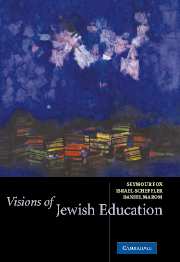Book contents
- Frontmatter
- Contents
- Preface and Acknowledgments
- About the Mandel Foundation
- Introduction
- Part I The Visions Project
- Part II Visions in Detail
- Introduction
- 4 What Must a Jew Study – and Why?
- Supplement: Isadore Twersky
- 5 Jewish Studies in Israel from a Liberal-Secular Perspective
- Supplement: Menachem Brinker
- 6 We Were as Those Who Dream: An Agenda for an Ideal Jewish Education
- Supplement: Moshe Greenberg
- 7 Reflections on the Educated Jew from the Perspective of Reform Judaism
- Supplement: Michael A. Meyer
- 8 Educated Jews: Common Elements
- Supplement: Michael Rosenak
- 9 The Concept of the Educated Person: With Some Applications to Jewish Education
- Supplement: Israel Scheffler
- Part III Visions in Context
- Conclusion: The Courage to Envision
- The Visions Project: Participants and Forums
- Index
Supplement: Isadore Twersky
Published online by Cambridge University Press: 08 January 2010
- Frontmatter
- Contents
- Preface and Acknowledgments
- About the Mandel Foundation
- Introduction
- Part I The Visions Project
- Part II Visions in Detail
- Introduction
- 4 What Must a Jew Study – and Why?
- Supplement: Isadore Twersky
- 5 Jewish Studies in Israel from a Liberal-Secular Perspective
- Supplement: Menachem Brinker
- 6 We Were as Those Who Dream: An Agenda for an Ideal Jewish Education
- Supplement: Moshe Greenberg
- 7 Reflections on the Educated Jew from the Perspective of Reform Judaism
- Supplement: Michael A. Meyer
- 8 Educated Jews: Common Elements
- Supplement: Michael Rosenak
- 9 The Concept of the Educated Person: With Some Applications to Jewish Education
- Supplement: Israel Scheffler
- Part III Visions in Context
- Conclusion: The Courage to Envision
- The Visions Project: Participants and Forums
- Index
Summary
In Isadore Twersky's view, the ideal Jewish education is halakhic education as conceived by traditional rabbinic Judaism. To formulate this ideal, Twersky drew upon the writings of Maimonides, whom he saw as traditional Judaism's most articulate spokesman.
Twersky analyzed Maimonides' writings on education using the same method with which he examined Maimonides' writings in other areas of halakhic life, such as prayer, charity, and the land of Israel. He would begin with a very close reading of the law on a specific subject, as summarized in the Mishneh Torah, paying particular attention to key conceptual terms. He would then make explicit the philosophical underpinnings of the legal stipulations, drawing on all of Maimonides' work. Finally, he would return to the Mishneh Torah to elucidate the relationship between philosophy and the law.
This process was Twersky's attempt to rearticulate, rather than newly interpret, the classical Jewish approach to a given subject. Despite challenges from the other scholars about the impossibility of any “objective” rearticulation, Twersky remained firm in his contention that he was faithfully representing Maimonidean thought, which itself “merged imperceptibly” with the sources of traditional Judaism.
Twersky applied this methodology to education by looking at Maimonides' summary of Jewish law in Hilkhot Talmud Torah (Laws of Torah Study) in the Mishneh Torah. Asking “What must a Jew study – and why?” he focused on a passage in which Maimonides identifies three units of the halakhic curriculum.
- Type
- Chapter
- Information
- Visions of Jewish Education , pp. 77 - 94Publisher: Cambridge University PressPrint publication year: 2003



